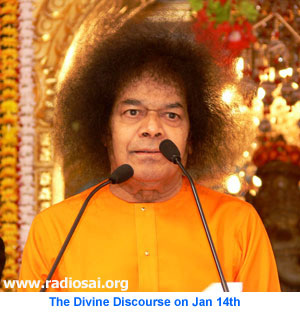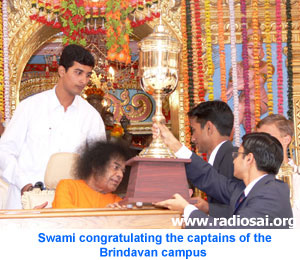 |
 |
 |
| Volume
4 - Issue 02 FEBRUARY 2006 |
|
PRASHANTI DIARY CHRONICLES OF HEAVEN ON EARTH The month of January is always special in Puttaparthi. Not only does it usher in the New Year but we see a varied variety of visitors that always thrills us. We not only see the remnants of the visitors from Christmas, but it is the time of the year when the alumni of the Sri Sathya Sai Educational Institutions come "home" to His Lotus Feet - for on the 1st of January every year for the past few years, Bhagavan has graciously permitted the former students to offer a musical programme in His divine presence. Just a few days later, on the 11th of January we have the Annual Sports and Cultural Meet of the Sri Sathya Sai Educational Institutions that attracts its own crowd - not only of alumni - but also the parents of the current students who come from far-off places to see their wards perform in front of the Lord. And add to this the usual crowd of devotees from all over the world and you get a good idea of the exciting mix of people that congregate here to usher in the New Year. In this issue we bring you a detailed coverage not only of the New Year's Day celebrations but also the entire Annual Sports and Cultural Meet along with a report on the 2 dramas that were presented by the students as part of the celebrations, and the Valedictory Function of the Sports Meet on January 14th. JANUARY 1ST - THE NEW YEAR'S DAY CELEBRATIONS The Morning Programme - The Institute Brass Band and Devotional Songs January 1, 2006 - New Year's morning was a joyous occasion for the Sri Sathya Sai Institute of Higher Learning Prashanti Nilayam Campus Brass Band for they were given the opportunity to usher in the New Year with their rousing tunes.
The Sai Kulwant Hall was beautifully decked up for the New Year by the Alumni of the Institute. The Mandir façade had floral wreaths hanging all over, punctuated at regular intervals by tastefully done circular floral bouquets. The pillars directly in front of the veranda had long vertical banners that read – Sri Sathya Sai Students. On the remaining pillars in front of the veranda there were banners wishing all devotees a Happy New Year in English, Telugu, Kannada, Tamil and Hindi.
The band greeted our beloved Swami with the powerful Breadfan, a salute piece with energetic drive and a strong rock beat provided by the percussion section. Hungarian No.2 played next, conveyed the valor fearlessness and the joy of being Sai Soldiers. The earliest work on the programme, a piece composed over 200 years ago, was a band arrangement of the much loved 1st movement of Symphony No. 40 by Mozart. The trombones and euphoniums play the driving rhythmic sounds played by the violas in the original symphony orchestra version. Fourth on the programme was the bhajan - Shankara.
The low brass played the open sounding chords expressing the awesome power of Shiva, while the upper range instruments played the bhajan melody. A favorite piece of the Institute boys is Adagio, which was played next. The soulful music conveys love and adoration for our dear Lord Sai. This piece is also often heard at the grounds during the Annual January 11 Sports Meet. The swinging New York, New York overflows with upbeat enthusiasm and cheerful freshness. To bring the New Years musical offering to a close, the band played La Bamba. This is Latin American dance music. Its energy was contagious and got the seated devotees swaying on their cushions. At the conclusion of their programme the musicians take a deep bow, silently expressing their eternal gratitude to Bhagavan for giving them this blessed opportunity to perform a concert in the Divine Presence.
After this prasadam was distributed and the arathi was performed. On His way back to Poornachandra Swami graciously cut the New Year cakes lovingly prepared for Him by the High School boys. The Evening Programme Of Music By The Institute Alumni We Love You Sai was an offering of devotional songs at Bhagavan's Lotus Feet by the former men students of the Sri Sathya Sai Institute of Higher Learning (SSSIHL) on the evening of the New Year Day. This year about 300 former students (alumni) congregated from not only from all the distant parts of India but also from all around the world. Boys had had come from countries like the USA, Canada, Russia, England, Australia, Spain, Saudi Arabia, and the U.A.E., Kuwait and Nepal and a few other countries. It was not just a mere reunion. The boys did some seva in the form of holding a medical camp to benefit the poor villagers of the area. This year they conducted the Medical Camp in the Gorantla Mandal – about 44 kms. from Puttaparthi. The Grama Seva involved about 5 villages and over 1600 patients and 2000 cattle benefited from it. Over 50 devotee doctors and veterinarians who came from Visakhapatnam served continuously for about 10 hours to diagnose the patients and dispense medicines. Narayana Seva was also done as part of the Grama Seva and over 3000 villagers were fed sumptuously. A detailed interactive session was held to educate the villagers on various common diseases and precautions to be taken for their own safety. The Grama Seva concluded with a Nagara Sankeerthan, congregational singing of the Lord's glories through the streets of the village.
Then a collage of soul stirring, emotion filled and melodious songs followed for one hour in different languages praising the Lord's many forms and leelas. With many singers present, each song was sung by 2 singers so that every singer could get the opportunity to offer their gratitude to Bhagavan personally. To avoid monotony, the songs were carefully and appropriately punctuated with simple poems composed in Telugu, reminiscing nostalgic moments of the students' love for Bhagavan.
On the flute was Ravi Teja accompanied by Balasubramaniam on the violin. Other accompanying instruments were the sweets sounds of the veena (played by Dr. Sridharan) and the harmonium (by Dr. Sonum). The percussion instruments were the tabla and the dholak (played by Sunil Narang, Rajagopal and Subhasish Daw) Swami asked the alumni boys to continue by singing bhajans and they responded magnificently leading the crowd in rendering for their Lord soul touching bhajans for over a half-hour. A beautiful passing smile on Bhagavan's face remained as a befitting reward for all to cherish in the end. And there is more! As if to confirm His happiness, Bhagavan granted the former students an opportunity to sing bhajans again in the mandir on the evening of the 2nd of January. JANUARY 11th -THE ANNUAL SPORTS AND CULTURAL MEET
The Annual Sports and Cultural Meet occupies an important place in the Institute Curriculum and its goal of an integrated system of education. This was well highlighted by the Vice-Chancellor Sri Anil Gokak in his speech at the Valedictory function on January 14th when he said, "The Annual Sports and Cultural Meet is an important component of our educational system. It shows that our's is an integral system of education which gives equal importance to the physical, mental and spiritual development of the student. The importance that is attached to the healthy development of the body is indicated by the manner in which the sports are organized. The development of the human body is a prerequisite for the development of a healthy human mind. That is the philosophy of Bhagavan Baba. This apart, the participation in sports adds to your other skills and qualities. It develops in you the qualities of perseverance, tenacity and courage. And above all, the skill to take appropriate decisions and actions in an emergency. The harmony of thought, word and deed is the prerequisite of a spiritual citizen and is assured by proper attention to the physical body. Let us recapitulate the oath that was administered to you on the Sports Day. There was a reference to fair competition, the honour of our country and the glory of sport and above all love for our beloved Mother Sai. In other words, human values and sports are woven together in our system of education. If only these were applied to the rules of everyday life: fair competition, brotherly love, learning how to win graciously and to lose with a smile on your face, things would be different in the country ."
For not only have the items to be developed but also the related uniforms have to be stitched and other props like the huge back-drop have to be completed for this oversize gala festival that will be held in the sprawling Vidya Giri Stadium. Swami on His part always gets involved in His own way with numerous visits to the Stadium. He also has discussions with the Vice-Chancellor and other concerned faculty members in Sai Kulwant Hall during the run-up to the Sports Festival and always gives His divine guidance and blessing to almost every aspect of the Meet. This year Swami first visited the ground on both the morning and the evening of the 4th of January. On both these visits He did not get down from the car but saw the events that the boys displayed to Him from inside the car itself. On the morning of the 5th, however, He got down from the car and spent an entire On the evening of the 6th the students of the Brindavan campus as well as the Anantapur campus arrived in Prashanti Nilayam. From the morning of the 7th, there was a combined all campus march-past practice every morning and a schedule was drawn up allotting time for each of the individual campuses in the Stadium to fine-tune their events for the big day. On the morning of the 9th, Swami again visited the ground and stayed there reviewing the all campus march-past as well as the rehearsal for the flag hoisting ceremony. He also blessed the mascot - a peacock- for this year's games. The mascot carries the flame up the hill and lights the urn that will stay lit for the duration of the day's events. Swami also paid a visit to the grounds on the evening of the 10th, just prior to the event, encouraging everyone by His presence. THE MORNING PROGRAMME BY THE PARTHI AND ANANTAPUR CAMPUSES Finally the all-important day dawned. The galleries started filling up early. The day was cool and clear. The entire stadium was decorated with flags and balloons as befitting the occasion. The marching bands that were to escort Swami into the Stadium were gathered in the North end, awaiting His car.
Swami made His entry at 8:00 AM sharp and was escorted into the stadium by the motorcycle riders and the marching bands of the educational institutions. Just after the marching bands were the Lions of Prashanti Nilayam. The Lions were part of the Lion Dance routine that was prepared by the Puttaparthi boys as part of their cultural programme for this day. After lighting the lamp to signal the start of the Games, Swami took His Chair at the center of the stage. Then six tiny tots - three boys and three girls - from the Primary School welcomed Him with bouquets and cards. After the girls came the boys of the Higher Secondary School in their bright T-shirts and finally the men of the Brindavan campus. The hosts - the Parthi students - brought up the rear. The Athletic squad medal winners were the last squad to enter the field.
The Parthi Campus Programme Then the Parthi students began their show. Generally a huge back-drop is created and the items are presented in the fore-ground. This year the Parthi students made a grand entry with a huge hexagonal shaped stupa (pillar) with Duty, Devotion, Discipline, Purity, Patience, and Perseverance written on its six sides. Right at the top was a swan around whose neck was a disc with the number 25 (white against a dark blue back-ground) to mark the Silver Jubilee of the Institute (which was opened in 1981).
On either sides of this hexagonal pillar were numerous cut-outs with Swami’s photographs on them. Two bright red banners with the words THE END OF EDUCATION IS CHARACTER and THE END OF KNOWLEDGE IS WISDOM formed a fitting back-drop. Between all these were giant models – 15 feet high and around 15 kgs. in weight - of ‘Sai Students’ dressed up either as Vedam chanting students, or in whites and some models were dressed as medical and legal professionals, and some were in a graduation robe. These models were specially designed and built for this occasion with the help of professionals from Mangalore and the uniqueness of these moving statues was that they were very light in weight and a single student could easily lift a model on his head and move around. After they all took their position, the Opening Ceremony song began. Groups of students danced to the tune depicting a mix of the East and the West, symbolizing a blend of spiritual and secular knowledge that is the hallmark of the Institute.
The second item was one of the main items - the Lion Dance. 30 "lions" barged into the ground dancing vigorously and exhibited a number of stunts on tables, poles and even did bamboo walking. Each lion was made up of two boys and they had to show an extra-ordinary sense of balance, co-ordination and strength to execute the different difficult items.
Subsequently came the Gymnasts displaying their mettle, performing all types of jumps – over fire, through rings and finally even over a Maruti Van! Following this were the drummers playing their rhythmic beats on 25 Chinese drums that were specially flown in from Singapore for this event.
The Delta Force came next to display their machismo. They held very heavy logs of wood and went through synchronized exercises, thus demonstrating that with unity even heavy weights are made very light. For the finale the real tough guys climbed upon the logs held vertically by the others. Acrobatics by the School children was the next item. Aeons ago, it is said, Lord Nataraja passed the knowledge of the Yogasanas to Mother Parvati through his beautiful dances, which eventually and ultimately was bequeathed to man, he being part of the Prakriti (nature) that the loving Mother Symbolises.
This was the very theme of the item put up by the students from the Sri Sathya Sai Higher Secondary School with the nomenclature TRANS DIMENSIONS. The fact that the age old Yogasanas had survived the tumults and ebbs of time was proclaimed aloud by the students driving out all the vexations doubts from the minds of people about our culture & heritage. The item commenced with a dance from Lord Shiva implying the afore cited cause after which the 40 or odd students (dressed in coordinated blues) started performing various asanas harmonizing their body movements to the beautiful, resounding symphony of music. Nataragasana, Vrikshasana, Bakasana, Sarvangasana and the fabulous Sheershasana are just a few to name, and of course, the performance of the tough Vrshihikasana (i.e. touching the head with toes while in handstand) on a rotating platform.
The final item of the Prashanti Nilayam campus was a Fun on the Run game involving a number of competitive games between two teams. Shooting balloons with catapults, putting balls through the basketball hoop after running through an obstacle course, a pyramid formation and so on. Based on the German games known as ‘Tele-match’, in this two teams - ‘The Red Dolphins’ and ‘The Yellow Reindeers’ - venture out in to the field.
The presentation came to a close with all the staff and students coming into a closing ceremony formation with a special closing song being played in the background.
The Anantapur Campus Programme
There were a number of jeeps and the girls used a number of props like a rotating wheel and bamboo poles to display various items that won them applause from the crowd.
THE EVENING PROGRAMME BY THE PRIMARY SCHOOL AND THE BRINDAVAN CAMPUS
The Primary School Presentation The primary School had made an impressive back-drop for the first song. A huge long painting spanning almost the entire width of the field that showed a lot of vanaras (monkeys) helping Lord Rama build the stone bridge to Lanka to rescue Mother Sita.
This formed a fitting back-drop for the first item wherein over a hundred boys dressed as vanaras danced to a fast beat. As the song progresses, it unfolds the story of Lord Rama and Lakshmana who had come to rescue Mother Sita and the monkeys helping them build the bridge across the sea to Lanka.
A feature of the primary school items is the involvement of almost the entire school in one item or the other. The girls of the school normally do an intricate dance and this year was no exception. A clutch of girls dressed in a blue skirt and a white top with a transparent cover around them like unfolded wings interspersed with other girls dressed in a white shalwar kameez outfit and draped with a red shawl holding hoops.
There were three vertical poles of different heights erected on the ground and the boys did pole climbing feats requiring body strength and dexterity. It was a very creditable display considering that they had trained for just 14 days for this item.
At the conclusion of their programme, the entire primary school stood in front of the dais and offered their pranaams to Swami. Presentation By The Deenajanodharana Campus
The Brindavan Campus Presentation It was quite late almost 5.35 p.m. when the Brindavan students commenced their presentation. The Brindavan campus offered at the Lotus Feet, a fusion of courage coupled with drama, strength supported by skill and beauty blended with agility.
The martial arts were displayed as combat between warriors. The first combat was between two warriors using the Toufa, a rice grinding tool as a powerful weapon of self-defence. On the other side there was a display of the use of Otta, a short curved stick designed to A third combat displayed how the key to success in any combat is the art of reading the mind of the opponent. 2 students deftly wield the Kettukari (quarter staff) although being outnumbered and emerge victorious. There was also a display of the use of the mace, made famous by Bhima in the Mahabharatha war. The mace needs more than brute strength, as its wielder must have an agile body and a sharp mind. There was also a display of the Oriental Martial Art, which is a synergy of technique that empowers the body and elevates the mind. Katas are a predefined set of movements which form the building blocks of karate. The boys displayed the Kata Taikuku shodan, and followed it up with the more advanced Kata Hian Idan. After all, eliminating weak and indecisive movements in Karate helps to eliminate weakness and indecisions in the mind. The Nunchaku is essentially a 2 section cudgel joined by a short chain. The whirling nunchaku can generate a whopping force of 400 lbs/sq inch and is considered the most dangerous blunt weapon in the world. The Ninjutsu warriors performed the double nunchaku blindfolded that had the audience enthralled.
The boys then displayed some breaking techniques in karate. Karate, after all, is all about generation of power in the region of interest. The tremendous focus of power attained in rigorous training is used by the students to shatter stone slabs at a fiery temperature. Six athletes also attempted to kick a football suspended about 9 feet in the air. This item required a lot of flexibility and suppleness and was originally a form of celebration. It was close to 6 PM. that all the Brindavan students came forward towards the dais and offered their gratitude to Bhagawan. Thus the curtain closed on this year’s Annual Sports and Cultural Meet. JAN 13th - A VIOLIN RECITAL AND A DRAMA BY THE PRIMARY SCHOOL On the 13th of January, at Swami's request, the Primary School re-staged a drama that was first staged earlier on October 23rd, 2005 during the Festival of Joy as we had also reported in our Dec 1st, 2005 issue. Swami had come early to Sai Kulwant Hall. However, the primary school drama that was scheduled to be staged that afternoon had a component where Swami's video was projected on a large screen that formed a back-drop for the drama in the front. So the kind and compassionate Lord had the bhajans conducted first, thus ensuring that the Sun went down and provided the right ambience for the Primary School kids to begin their drama. A violin recital by the Primary School girls preceded the drama by the Primary School boys. The Violin Recital By The Primary School Girls
About 38 girls from classes 6th to 11th of the Sri Sathya Sai Higher Secondary School gave a beautiful violin concert consisting of 5 songs. They first played 3 Scottish and 1 American folk dance songs. For the last piece they played the popular bhajan - Madana Mohana. This effort was quite creditable since they learned all the songs in a short period of just 2-3 weeks. The Primary School Drama - Sai Prema Dhara
Eminent devotees like Sri Kasturi and Sri John Hislop were used as raconteurs who introduced the events and narrated a commentary to telling effect as the events unfolded. The childhood events were very heart warming for it showed the little kid Sathya getting fruits out of season for his playmates; little Sathya showing the cosmos in His open mouth to Subamma was also portrayed while drawing a comparison to Lord Krishna doing the same by showing the cosmos to His mother Yasoda.
Other incidents portrayed were the one in which the village boys carried Sathya on a palanquin calling Him their guru, the story of the sacrifices that Sathya made to attend the scout camp and the service activities carried out by Him and His playmates, and the famous incident at the Virupaksha temple in Hampi where Sathya stood outside to look after the luggage but was also simultaneously seen inside the sanctum sanctorum as the deity of the temple.
The finale of the drama was very interesting wherein the students dressed in whites are seen asking relevant and appropriate questions in the foreground and Swami seems to answer the questions (the "answers" are actually video clips from a number of Swami's discourses) through the projector screen in the back-ground.
The play concluded with all the children gathering together in front of Swami and singing the song Madhura Mohana Ghana Shyama Sundara Sai…..
JAN 14TH - THE VALEDICTORY FUNCTION IN THE MORNING AND A BRINDAVAN CAMPUS DRAMA IN THE EVENING After the Sports events finishes on January 11th, the prize distribution and valedictory function is held on January 14th. January 14th is also a significant harvest festival called Makarasankranthi (also called as Pongal) that is celebrated all over India . The Morning Programme
"Today is Makara Shankranthi, which is indeed auspicious as it heralds the arrival of a new spirit and it is, especially for those in the North, the culmination of winter and there bonfires are lit, sweets are given out, puffed rice is thrown into the fire and the festival is celebrated in a very joyous atmosphere. In some parts of the country sesame seeds are consumed in various forms. The idea is that sins will be washed away by this act of purification. Uttarayana is associated with Makara Shankranthi because the Sun enters Makara Rashi Uttarayana and I hardly need recapitulate the story of Bhisma which is intimately connected with Uttarayana. Bhisma who led the army of the Kauravavs and was lying on a bed of arrows until the tenth day did not want to go to the heavens during Dakshinayana - he wanted to wait until Uttarayana. And therefore he prayed to Krishna who rushed to his bedside. It was only after worshipping Krishna that Bhisma breathed his last. The belief was that if you do not breathe your last during Uttarayana you may still be subjected to the agony of the cycle of birth and death. " After this brief speech by the Vice Chancellor, in a marked departure from the usual custom, Swami requested that the table be brought up in front as He wanted to give His divine discourse. In the course of His Divine Discourse where He asked everyone to discharge his duties with a sense of surrender to God, Swami said,
After the Divine Discourse, Swami next distributed the championship cups to the House winners of the Brindavan, Puttaparthi, Anantapur, the High School, the Music College and the Primary School campuses. He also blessed and handed over the certificates to the winners of all the different games to the principals of the colleges so that they could be distributed later to all the winners in a function held in their respective hostels. After this programme was over, Swami stayed in Sai Kulwant Hall till prasadam was distributed to all before retiring to His abode. Adikavi Valmiki - A drama by the Brindavan Students The students of Bhagavan from the Brindavan campus were blessed with an opportunity to stage a drama entitled 'Adikavi Valmiki' on January 12th in the Institute Auditorium and again on the evening of January 14th in front of the assembled crowd in Sai Kulwant Hall. The drama was staged in 2 levels - one part with dialogues and songs mostly in the foreground with the stage at the ground level and the other (mostly) miming the scenes in the background on a higher level stage about 5 feet above the ground. This arrangement coupled with effective sets, attractive costumes and exhilarating music and dance kept the audience enthralled for an entire hour. The display began with a sloka on Sage Valmiki, followed by a precise and brief introduction by the two sutradhaaras (raconteurs).
The first act, that begins dramatically with the entry of the Saptharishis (seven seers) was set to the song Daivam maanava, and portrays the tale of how Ratnakara, a forest brigand is transformed to the sage Valmiki. The sages advise Ratnakara to see if his family would also share the sins that he commits through the robbery that he resorts to in order to feed his family. When his wife refuses to share the sins, Ratnakara is shocked and spends years meditating on the name of Rama and is transformed to the sage Valmiki. The sweet and melodious song O Ramaneenaama is sung to glorify the transformation of Ratnakara into Valmiki.
Important events from the Ramayana from the birth, marriage, exile, Sita's abduction, Hanuman as Rama's messenger to Sita in Lanka, the end of Ravana, the Agni Pariksha of Sita (the test by fire) till Rama's Pattabhisekham (coronation) were magnificently displayed by the students donning authentic puranic costumes while the sweet Ramakatha song was sung by the students.
The drama concluded after the portrayal of the coronation with a wonderful feet-stepping dance praising Lord Rama as our Bhagavan in this age - Ramayye Rajayyenanata.
As perhaps most of you know, Swami left for Brindavan on January 20th, 2006. Most of the major functions and events when He is in Brindavan will be covered for you in our next issue. So till we meet again on March 1st, we wish you the very best. Jai Sai Ram!
|
| You can write to us at : h2h@radiosai.org |
Vol 4 Issue 02 - February 2006
|
Best viewed in Internet Explorer - 1024 x 768 resolution. |
DHTML Menu by Milonic. |





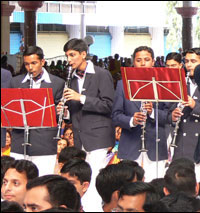
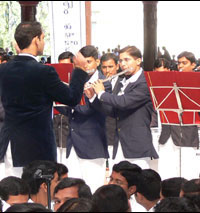
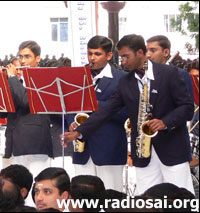


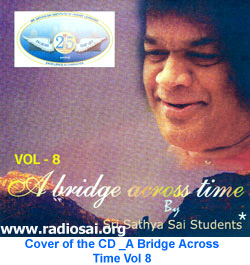
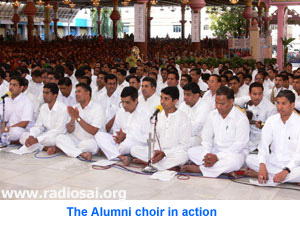
 The eminently gifted musicians were ably supported by an equally talented group of instrumentalists that made the concert a very memorable evening. There were 2 key-boards (Hariharan and Darshan Kulkarni) and 2 guitars (played by Anupam and Vishal).
The eminently gifted musicians were ably supported by an equally talented group of instrumentalists that made the concert a very memorable evening. There were 2 key-boards (Hariharan and Darshan Kulkarni) and 2 guitars (played by Anupam and Vishal).  The Annual Sports and Cultural Meet is the first major festival event after the New Year is ushered in and is held on the 11th of January every year. It is a joyous occasion as the students of all the three campuses of the Sri Sathya Sai Institute of Higher Learning, the Higher Secondary and also the Primary School students all come together in Prashanti Nilayam and perform cultural activities before the Lord.
The Annual Sports and Cultural Meet is the first major festival event after the New Year is ushered in and is held on the 11th of January every year. It is a joyous occasion as the students of all the three campuses of the Sri Sathya Sai Institute of Higher Learning, the Higher Secondary and also the Primary School students all come together in Prashanti Nilayam and perform cultural activities before the Lord. 
 But from the middle of December thoughts turn to the cultural items that they will perform in front of the Lord. A lot of work goes in, and the faculty and staff are fully involved.
But from the middle of December thoughts turn to the cultural items that they will perform in front of the Lord. A lot of work goes in, and the faculty and staff are fully involved.  hour reviewing the Sport events prepared by the Prashanti Nilayam campus.
hour reviewing the Sport events prepared by the Prashanti Nilayam campus.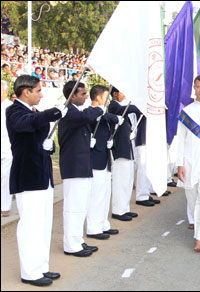
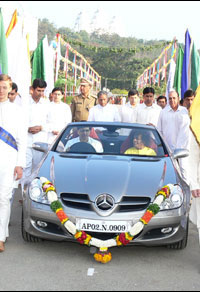
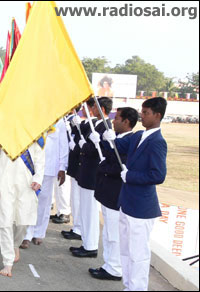


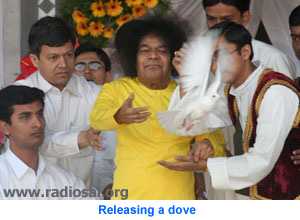
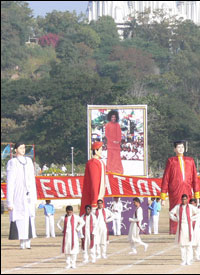
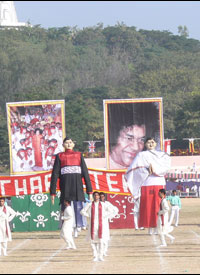
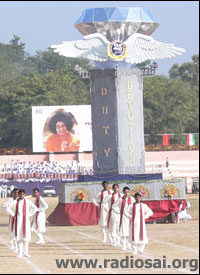


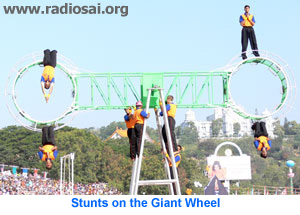

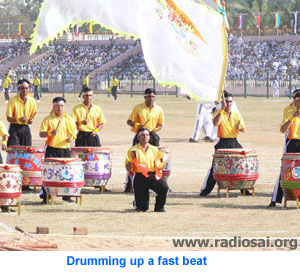


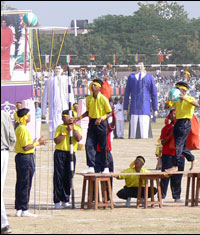
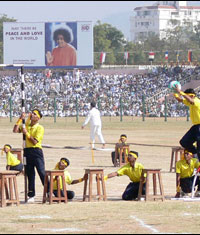
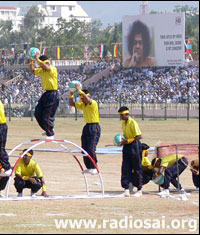

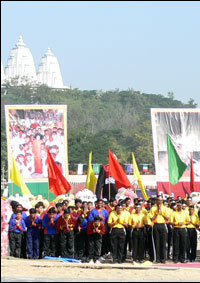
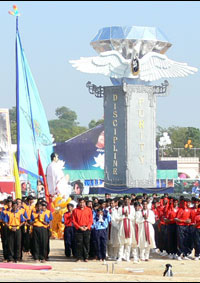
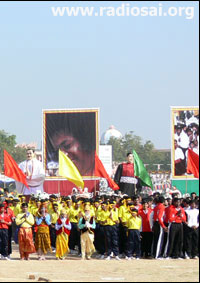

 Following this was a butterfly dance - a mass item with a hundred plus girls with butterfly wings that turned shining silver and bright gold as they changed sides. The formation was maintained immacutely and the movements synchronized perfectly to give a good visual treat to the audience.
Following this was a butterfly dance - a mass item with a hundred plus girls with butterfly wings that turned shining silver and bright gold as they changed sides. The formation was maintained immacutely and the movements synchronized perfectly to give a good visual treat to the audience. 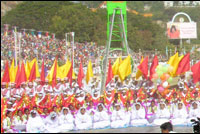
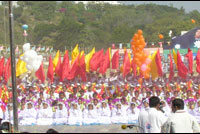
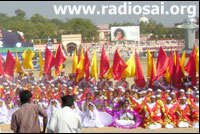







 While the dance item was going on in the background, a bunch of 33 skater kids dressed in red took their positions just to the left of the dais.
While the dance item was going on in the background, a bunch of 33 skater kids dressed in red took their positions just to the left of the dais. Next item on the primary school agenda was a pole drill by about 87 boys from the 5th, 6th and the 7th class.
Next item on the primary school agenda was a pole drill by about 87 boys from the 5th, 6th and the 7th class. 



 paralyze the opponent, and a spear was pitted against the sword.
paralyze the opponent, and a spear was pitted against the sword.

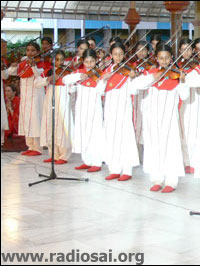
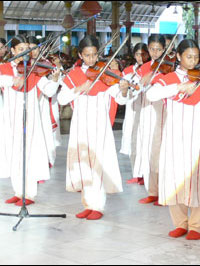
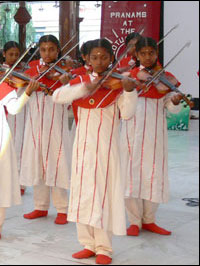






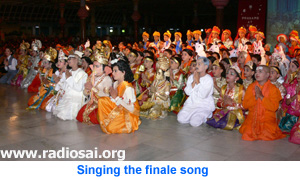

 Speaking on the occasion of the Valedictory function of the Sports Meet, the Vice Chancellor alluded to the importance of this festival and said,
Speaking on the occasion of the Valedictory function of the Sports Meet, the Vice Chancellor alluded to the importance of this festival and said,